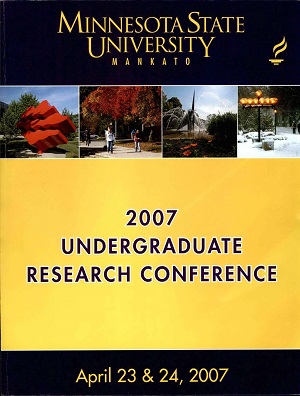Wild Rice: National Food or Sacred Crop?
Location
CSU 201
Start Date
24-4-2007 8:30 AM
End Date
24-4-2007 9:30 AM
Student's Major
Accounting and Business Law
Student's College
Business
Mentor's Name
Vicki Luoma
Mentor's Department
Accounting and Business Law
Mentor's College
Business
Description
Wild rice may not seem like it is an important crop to most, but to the Anishinaabeg it is a way of life. Since they have inhabited the Great Lakes area, the Anishinaabeg have harvested wild rice and it has become a staple food and a major source of income for the community. Today, the University of Minnesota is conducting research in genetic engineering to produce an easier to grow species of wild rice that has the potential to cross pollinate with the wild rice that the Anishinaabeg harvest. The introduction of a new species of wild rice carries with it the potential to sterilize the natural form of wild rice, causing extreme hardship for the Anishinaabeg. Not only would this have a disastrous effect on the Anishinaabeg's income, but it would destroy their sacred crop, which is very important to their cultural traditions. While genetic engineering of plants and crops does not generally raise a legal issue, in this case legal issues do arise because of the existence of a long history of treaties and other legal precedents involving the Anishinaabeg. This research project will examine the legal authority that applies in this instance and whether treaty rights would be violated by the introduction of genetically engineered wild rice into the natural environment.
Wild Rice: National Food or Sacred Crop?
CSU 201
Wild rice may not seem like it is an important crop to most, but to the Anishinaabeg it is a way of life. Since they have inhabited the Great Lakes area, the Anishinaabeg have harvested wild rice and it has become a staple food and a major source of income for the community. Today, the University of Minnesota is conducting research in genetic engineering to produce an easier to grow species of wild rice that has the potential to cross pollinate with the wild rice that the Anishinaabeg harvest. The introduction of a new species of wild rice carries with it the potential to sterilize the natural form of wild rice, causing extreme hardship for the Anishinaabeg. Not only would this have a disastrous effect on the Anishinaabeg's income, but it would destroy their sacred crop, which is very important to their cultural traditions. While genetic engineering of plants and crops does not generally raise a legal issue, in this case legal issues do arise because of the existence of a long history of treaties and other legal precedents involving the Anishinaabeg. This research project will examine the legal authority that applies in this instance and whether treaty rights would be violated by the introduction of genetically engineered wild rice into the natural environment.
Recommended Citation
Kofstad, Nathan; Andrea Laabs; Steven Loerzel; and Mark Mageskau. "Wild Rice: National Food or Sacred Crop?." Undergraduate Research Symposium, Mankato, MN, April 24, 2007.
https://cornerstone.lib.mnsu.edu/urs/2007/oral-session-10/1




